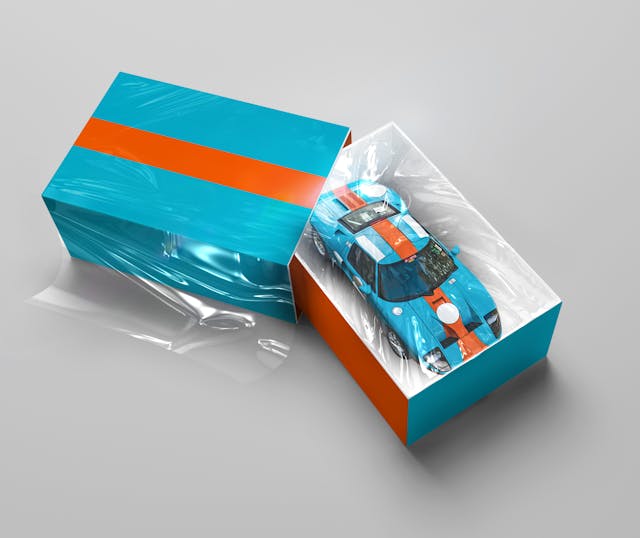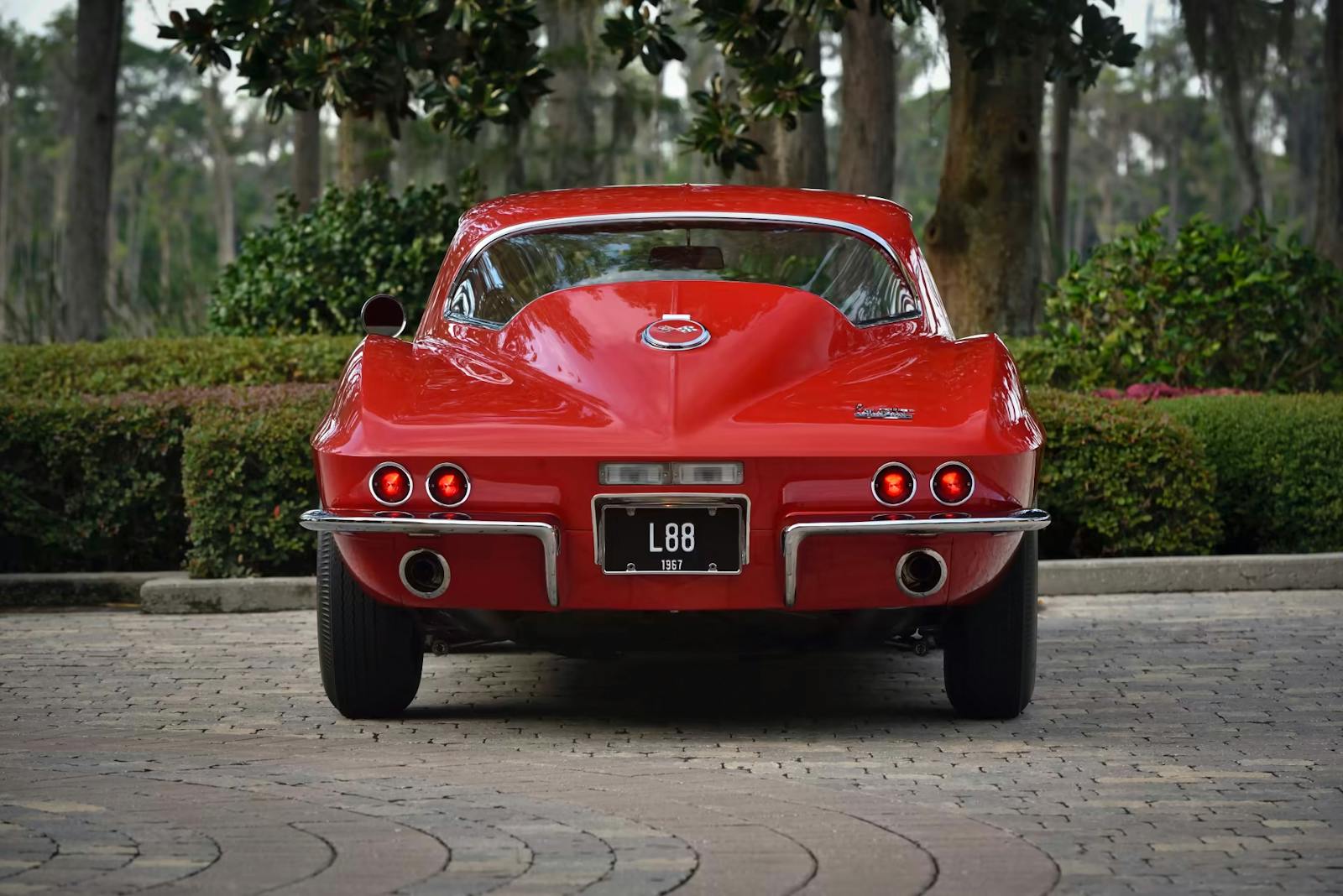Understanding “wrapper” cars
Somewhere, in a garage near you, there is a car covered in plastic. It is as perfect as new cars get: no modifications, every OEM part and wire in place. This car has been started at least once, maybe twice—possibly even three times—in its life. The odometer might show 5 or 10 miles; the tires are original; the seats are wrapped in the original protective factory transit plastic.
This car wasn’t built yesterday. It probably wasn’t even built this year, or in the past 10. Shortly after construction, it was rolled off a transporter and parked, sold but unregistered. It’s known as a “wrapper” classic, and for some people, the appeal lies in the fact that it has not been used for transportation. That it likely never will be.
The wrapper-car phenomenon is not new. These machines have existed quietly on the fringes of the collector car world for decades, traded occasionally in public but far more often in private. The practice can seem mystifying—who would buy a car and not want to drive it at least once? Nor does it discriminate in age or spec. There live in this country quietly sleeping wrapper versions of base-spec, six-cylinder ’60s Mustangs, their interiors mummified and their seatbelts rolled up in original transport bags, but also first-generation Ford GTs in the wrapper, only 2 or 3 miles on the clock. Those six-cylinder Mustangs may be worth thousands less than you might guess, valuable only to a small group of people; those GTs almost certainly have far wider appeal, plus a market value five or six figures more than a nearly identical “driver” GT—one that might have a whopping 500 miles on the odometer.

The people who look after these vehicles see them as mementos, static sculpture representing a bygone time. These collectors may own similar or even identical cars for actual use, but wrappers serve a different purpose. Combustion is the enemy here, unboxing a defeat of the purpose, sunlight exposure a minor sin.
“The thing you have to remember,” Mark LaMaskin says, “is that nobody buys a wrapper car to drive it.”
LaMaskin runs Performance Autosport, a Virginia firm specializing in Ford and Saleen products, wrappers among them. A world-renowned Saleen authority, he has been buying and selling cars since the age of 16.
“People don’t understand,” LaMaskin says. “They think, ‘Why would someone buy a car they can’t use?’ It’s because they’re buying it for the memory. They’re buying it for the nostalgia. For the fact that they read about the car when it came out, and it was new, and nobody has messed with it.”
You would expect there to be investment potential here, and there is. Some wrappers plateau in value and never appreciate further, barely keeping up with inflation. Others can be virtually guaranteed to provide significant return. But money is rarely the prime motivation.
“It’s part of an investment collection, yes, number one,” LaMaskin says. “Number two, the guy that typically buys a wrapper car, he’s owned those cars in the past. He’s put lots of miles on it … he doesn’t need to drive that car in order to get the joy out of it. He’d rather be able to relive what he had as something new, undriven … he’s getting to do it all over again.”
As with any automotive subculture, there are marque-specific knowledge bases and unique terms. Colin Comer, Hagerty’s marketplace expert, notes that wrapper cars are usually selected for preservation based on market perception.
“Generally speaking, it’s stuff where people thought it would be the last of its kind. The 1976 Cadillac Eldorado convertibles, they all have no miles on them. The 1993 Mustang Cobra Rs, if they weren’t raced, they all have zero miles. The ’67 Corvette—oh, this is going to be the last of the Sting Rays, we better put this away, or it’s the last of the Fox bodies, and so on.”
The other common thread is desire—wrapper buyers tend to know exactly what they want. This almost always means a specific year, marque, and model, and often a certain combination of color and trim. But some collectors, Comer says, want hyper-low-mileage wrappers only, which usually means under 50 miles. Some won’t consider a purchase if a car has more than 10 miles. There is also often a degree of horse-trading in collection management, where an owner of, say, a 10-mile car might be happy with it until someone offers to sell him an identical, 5-mile example, at which point the 10-mile car goes out the door.
Some collectors, LaMaskin notes, are interested only in the rare air beyond that—machines that haven’t even been dealer-prepped, where the selling dealer simply rolled the car off a transporter and right into storage. Those cases bring a host of obvious traits, from shipper or port writing on the windshield (often shoe polish or water-soluble paint) to extensive exterior protection (grille covers, factory plastic transport wrap still on the sheetmetal) and a general sense of visual pickling.
“A lot of people don’t know what ‘dealer-prepped’ means,” LaMaskin says. “Pre-dealer-prepped cars are even harder to find. When a car comes from Ford, for example, the seats and door seals are covered in plastic. There’s writing all over the windows, check sheets on stuff. The dealer [normally] gets paid to pull all that plastic off and put it on the showroom floor. They hate not doing all this because they want to be able to inspect the car, make sure it’s OK.”
Unprepped wrappers are rarest of the rare, the ne plus ultra of wrapper collecting. And while wrapper etiquette holds that the cars aren’t for driving, when a vehicle hasn’t been dealer-prepped, you wouldn’t want to drive it. With a windshield covered in writing and plastic flapping at speed, an unprepped wrapper would be like rolling down the road in a deflated, nearly opaque balloon. “You don’t have the fun driving experience,” LaMaskin says. “You have the guy-who-drives-the-car-off-the-trailer experience, because that’s what it was like when they unloaded it.”
If you’ve spent any time around vintage cars, the wrapper passion can be difficult to parse. Like many folks, the Hagerty staff tends to believe in the power of motion, and that a shared experience trumps a singular one. Automobiles are nothing if not industrial design, and one of the prime tenets of industrial design holds that a machine is never so attractive or appealing as when in use. With cars, this has traditionally meant road time—and the repair and restoration required to make that happen.
That said, this company has also long believed that vintage cars exist primarily to generate joy and to keep alive the lessons of history. Driving may seem the most obvious route to those ends, but that doesn’t make it the only one. Nor is wrapper collecting likely to go away; modern cars are often more suitable for the pastime than their vintage counterparts—more durable and storable on many fronts—and they’re just as capable of telling stories to future generations.
No matter what you think of wrapper cars, it helps to remember the point of the interest—enjoying the machine, in whatever form that may take.
“For these guys,” LaMaskin says, “it’s a piece of art.”
__
Sam Smith is an editor-at-large for Hagerty. He has written for The New York Times and Esquire and is a former executive editor at Road & Track.
***
Check out the Hagerty Media homepage so you don’t miss a single story, or better yet, bookmark it. To get our best stories delivered right to your inbox, subscribe to our newsletters.


